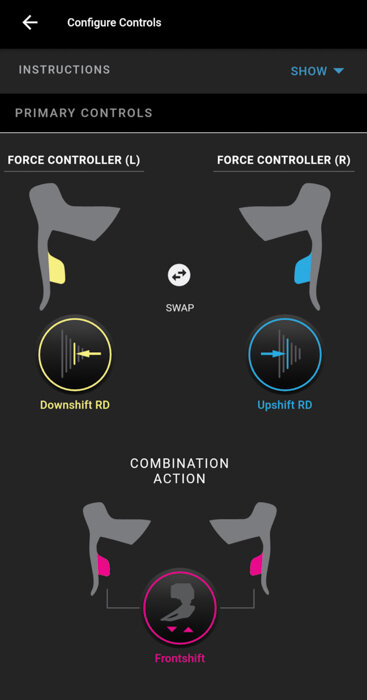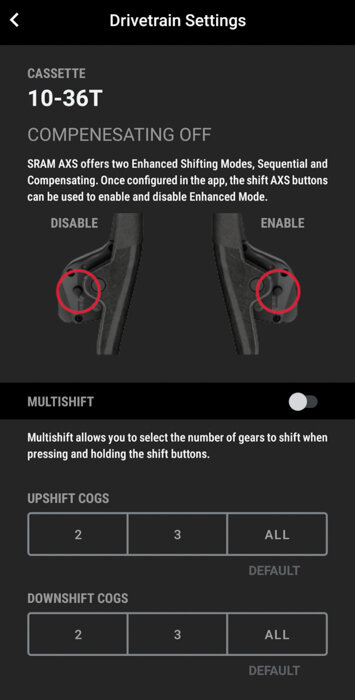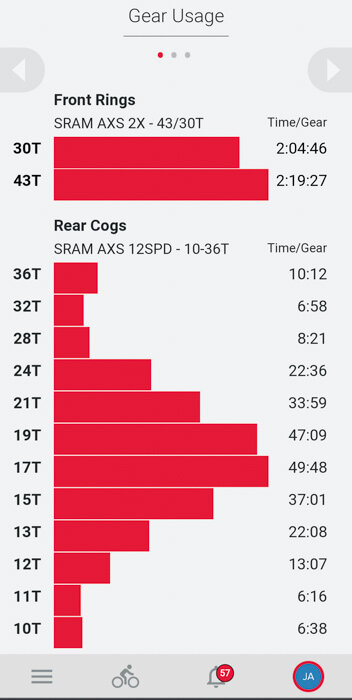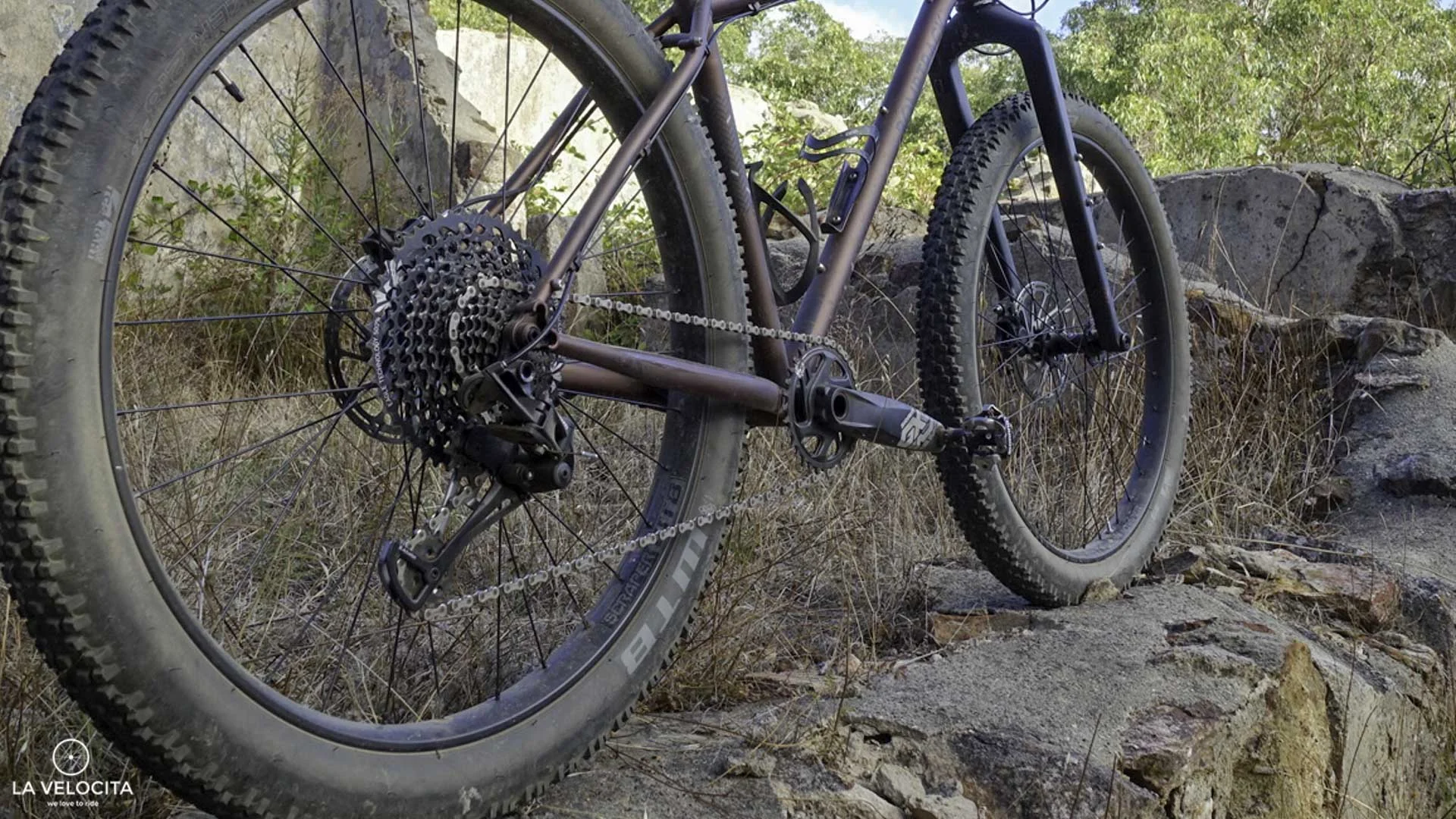SRAM Force eTap AXS wide gravel groupset review

SRAM FORCE eTap AXS IS AN IMPRESSIVE GRAVEL GROUPSET WITH AN EQUALLY IMPRESSIVE PRICE TAG. IS IT WORTH YOUR HARD EARNED CASH? LET’S FIND OUT!
Words & images - James Raison
There’s no escaping that SRAM’s range-topping Force eTap AXS WIDE gravel groupset is very good. I’ve been riding it since July 2020 through the deep slop of winter to the blazing hot South Australian Summer and I’ll tell you at the top that I’m a fan. But, with a price tag of around $4,500 in the spec you see, it’s not as simple as giving it the big ‘ole thumbs up and sending people out to buy it. Part of the lengthy review time was caused by uncertainty around just what my thoughts would be. It’s a damn good groupset, but costs more than a good gravel bike. So, let’s embrace some nuanced thinking and jump into the review.
WHY DID SRAM GO WIDE?
SRAM Force eTap AXS Wide is an adaptation of regular Force eTap AXS that addressed two limitations: insufficient tyre clearance and an aggressive gear range that was only suitable for flatland and fairly narrow-tyred dirt. Force eTap AXS Wide introduced a wider range 10-36 cassette and compatible rear derailleur, widened the crankset stance by 5 mm to give better tyre clearance, and developed a crankset with 43/30t rings and front derailleur to go with it. The cassette and rear derailleur are designed to work together in tandem as are the front derailleur and crankset. The shifters, brakes, and batteries are compatible across the rest of the SRAM eTap AXS ecosystem.
In short, the eTap AXS Wide update has made it a viable all-round gravel groupset with a superb gear range.
My Grove R.A.D gravel rocket came up very nicely with the new groupset
PRICING
Firm pricing on a complete groupset is hard to find because the “Wide” adapted parts are sold independently rather than all together. Plus, all the COVID supply chain complexity is making things hard to find. So, below is a ballpark breakdown of prices based on some current research:
Full groupset: $4500 roughly
SRAM Force Wide 12 Speed Crankset - $699
SRAM Force eTap AXS Wide 12 Speed Front Derailleur - $669
Derailleur, chain and cassette - $1199
Shifters + brakes each - $849
2x batteries - $160
Charger - $70
Rotors - $140
TECH GEEKERY PART
As a massive nerd, the SRAM eTap AXS ecosystem is a lot of fun for me. Being able to park on the couch, fire up a phone app and drill into the groupset’s settings was quite the novelty, and I spent the first few weeks trying a little bit of everything to dial in the behaviour I wanted. So, what can you do with the groupset?
WIRELESS IS BETTER
Each part of this groupset is blessed with the ability to independently communicate via BlueTooth and that makes so much of the tech magic happen. Electronic function setup and pairing are beautifully simple, with each component having its own pairing command button. Hold the AXS pairing button down until the indicator light on the component flash, and they’ll start talking to each other. Connecting to your phone lets you immediately update firmware on each component.
The AXS button is how you pair parts together
Bike building is simplified with only the hydraulic hoses running through, or around, the frame. I enjoyed the aesthetic cleanliness of cable and wire-free builds as well.
AXS APP
SRAM’s AXS phone app lets you carry out a bunch of handy functions; update firmware on components, check your battery life, link off to the SRAM AXS web app, and tweak some shifting options.
The “Enhanced Mode” compensatory shifting lets you tell the rear derailleur to automatically shift one or two cassette cogs when you move chainrings. It means, theoretically, holding a smoother cadence after moving chainrings. I deactivated Enhanced Mode after a few rides though because it’s too disruptive to your pedalling to have both derailleurs moving at once. Similar systems on road groupsets can be quite natural, but the added bumping and different traction requirements of gravel don’t suit automatic shifting in my experience. The rear derailleur can handle shifting under load at high torque quite well, but the drop in pedalling torque needed to allow a front and back shift at once can feel clunky and awkward.
There’s a “Multishift” option where you can define the maximum number of cogs you want to shift on extend presses of the shift button. You can set it to 2, 3, or All - which means it’ll keep moving until you stop holding down the button. Again, I kept “All” because I didn’t find it necessary to limit shifting on a 2x. Dropping chainrings was usually the big gearing change I need and extensive rear derailleur movements weren’t often necessary.
AXS WEB
There’s a very cool and hyper nerdy ability to link Garmin Connect and Wahoo ELEMNT apps to SRAM AXS so people who connect their drivetrain to compatible head units can see detailed gear usage stats and ride data.
I used the system as inspiration for an article on gravel gearing guides because it gave me time spent in each gear. I was very satisfied by the clean bell curve showing the mid-cassette is where I spend most of my time. There’s plenty of time spent in the 36t and 32t as well. The system can even match in power data for another layer of geeking out.
BATTERIES AND CHARGING
SRAM brings the best charging system to electronic groupsets, in my opinion. It’s an “ecosystem” battery with the same unit used across all AXS derailleurs and RockShox Reverb AXS seatpost.
Attaching batteries to each derailleur makes for an easy, detachable solution
What the batteries lack in outright longevity - claimed 1000 km of riding - they gain back in size and convenient charging. They weigh a feathery 24 grams, which makes them ostensibly equal to the 50g Shimano Di2 battery. Removing them and dropping them into the charging cradle takes seconds and there’s only a micro-USB cable required. You do need to BYO wall plug or use anything else that has USB charging out, even a dynamo hub. You can check the battery levels in the AXS app, or add a battery indicator to compatible head units. I’m not exactly sure which battery level is indicated on my Garmin Edge 530 because there’s only one indicator but two batteries.
I love the ease and convenience of SRAM’s battery system. I went weeks between even thinking about charging and the lowest I ever got was around 30%. I’m an attentive battery charging person though, so I had no problem remembering to check power levels before long rides. I intentionally ran the batter to see what would happen and was happy to see multiple warnings from the app and Garmin head unit. Eventually, the front derailleur ran out on a ride and I big-ringed it home.
I love the convenience of SRAM’s charging system
There’s some scepticism around the ability to keep batteries like this and it depends entirely on you. If you’re hopeless at remembering to charge batteries then it might be a problem. If not, you’ll be fine. Either way, it’s a reflection of you and not the groupset or battery quality.
The biggest problem I have with the battery system is the CR2032 batteries in the shifters. They last a long time but they’re a disposable battery and I find that unpalatable in 2021.
SHIFTING
Force eTap WIDE continues the wireless shifting trends that SRAM began with its original 11 speed eTap: pleasingly reliable, simple to operate, but far from stunningly fast.
One button per paddle keeps the shifting simple
You have a single shifting paddle on each lever; pressing the right paddle moves the chain right, left moves it left, and both paddles together execute a chainring change. I like the simplicity of the single button but I stitched myself up multiple times changing chainrings. The command is always “change chainrings” but you might not realise you’re already in the ring you wanted. It took me some time to adjust from the 1x DRX Di2 setup I’d been using for months. I employed a party trick of the wireless shifting and connected it all up to my Garmin Edge 530 to see exactly what gear I was in.
REAR DERAILLEUR
Shifting at the rear is reliable and the derailleur can handle moving under load. I’m not going to say it’s fast as such. Shimano’s Di2 groupsets and a few mechanical groupsets have it handily beaten for outright speed whether it’s an individual gear shift or moving through the whole cassette. Prospective buyers shouldn’t expect to get their socks knocked off by blazing fast derailleur movement.
The Orbit Damper keeps effective tension on the chain
The tension system, or “Orbit damper” in the official SRAM vernacular, genuinely impressed me. It kept chain bounce to a minimum and didn’t feel like it added in drag into the drivetrain. There was only one minor hiccup in my months of testing where the chain bounced from the big ring to small as I hammered across some rocks. That’s it. It’s been more reliable than either 1x SRAM or Shimano drivetrain I’ve also used extensively. SRAM just seems to have figured out their rear derailleurs for offroad drivetrains. I really have a single small gripe. I’d like a switch so I can fully extend the derailleur cage and lock it in place for cleaning. It’s something that I got used to with SRAM Eagle and SRAM Apex. The Force AXS derailleur is chunky, pointy, and generally hard to clean well.
Overall, rear shifting exists in a bit of a nowhere “pretty good” zone. It reliably and dutifully moves the chain between cogs, but it lacks what I call “zing” and “clang”. There’s something about SRAM’s electronic wireless shifting that lacks speediness. It’s something I noticed in their 11 speed Red eTap, and it feels to have carried through to the 12-speed ecosystem. It’s the same story with the “clang” - which is the visceral feedback that a gear has most certainly changed.
FRONT DERAILLEUR
SRAM’s front derailleurs on the electronic drivetrains are tricky beasts.
On a positive note, shifting between chainrings is reliable. It’s just a little laggy on the upshift, though. The motor moves fast enough, but it takes a moment for the chainring guides to ramp the chain up onto the big ring. Downshifts feel snappier and the chain drops quickly onto the little ring but I do find myself backing off the power to let the chainrings change cleanly.
The front derailleur is a chunky but nonetheless rather cool looking piece
Tolerances are ultra-fine when setting up the front derailleur. The yaw motion means the working range is small. SRAM includes a guide to help with setup, which sets an expectation out of the box. My biggest concern for gravel applications is the tyre clearance though. It’s rated to work with 700x45c and 27.5x2.1" which is fine for the market today, but I expect it’ll be a problem as the gravel market continues widening. Plenty of new generation gravel bikes are designed to accommodate chunkier tyres over 700x50 and 27.5x2.25”. Clearance will be a limiting factor before long. Even with narrower 700x4omm rubber, I found mud would build up and fill the gap between battery and tyre. Bigger tyres mean less clearance and more build-up.
The clearance between the battery and 700x40mm tyre is quite tight
GEAR RANGE
The new 10-36 cassette and 43-31 chainrings added together give a simply superb gear range. It’s the best range on the gravel market. It covered me from stem-chewing and loose climbs at 7-9 kph at a reasonable cadence, all the way up to 60 kph without too much furious spinning on the 43x10.
Behold, all the teeth!
I did some data crunching with the SRAM AXS platform and fit files from my head units. Tethering the drivetrain to my GPS unit stored shift data and the AXS web app will track your gear usage. I did a full article on gravel gear guides but the short version is that I used the entire 10-36 cassette with a healthy distribution around the middle.
Check out this video I made about gravel gearing to see a deeper dive on the topic.
BRAKING
There’s healthy power and decent modulation with the Force brakes, but it’s a little too familiar to the old 11-speed HRD generation. That’s not to say it’s bad, quite the opposite. Power is bountiful but you have a short lever throw to from a bit of power to a lot of stopping power. You need to carefully manage the lever on loose descents to avoid locking the wheels.
Solid performance, and mercifully quiet performance from the brakes
SRAM’s Force AXS, eTap HRD, and Shimano’s hydraulic road Di2 groupset all fall close to each other in terms of power and modulation. They’re all solid systems and I’ve been happy using them all. Shimano’s GRX Di2 is, by far, the best drop bar braking system I’ve used. GRX Di2 matches the power of the SRAM groupset but easily surpasses it with precise modulation thanks to the higher pivot point. The Force AXS’s brakes are good, but Shimano GRX Di2 is just better.
Happily, SRAM has managed to reduce the braking noise common across their range. The legendary SRAM “gobble” is largely absent here but did creep in when I trialled a set of Avid Elixir pads. Squealing was minimal as well, only happening in soggy conditions.
LIVING WITH IT
I can barely fault the Force AXS Wide for its ride and living-with-it test.
I do want to point out some strange noises when moving to a new chain. After 900km I replaced the chain with a new one treated with Absolute Black Graphenlube. The original chain was far from needing replacement, but the drivetrain made such a horrible grinding sound on the small chainring that I thought something was broken. A mechanic confirmed there was nothing wrong, there was negligible wear on the small chainring, and I had to give the chain and chainrings a few rides to accept each other. They did, and the noise went away. It could be a precursor to fast wearing chainrings but I’ll need more time to get them to end-of-life.
This is what it’s all about! This SRAM groupset has seen some adventures
Other than that, the groupset has performed exceptionally well across the tough conditions I’ve been using it. The months of winter slop saw it filthy and coated in mud while the blazing summer baked it in the sun while fine dust got into everything. I can’t think of any reliability problems or annoyances.
That all said, a groupset this expensive should work this well and be so reliable. I couldn’t help but feel something would go wrong though given the brutality of using wireless electronic tech in the harsh outdoors. It didn’t though. I’d confidently take this groupset adventuring and bikepacking like the mechanical and Shimano’s GRX before them.
MARKET POSITIONING AND COMPETITION
This groupset represents an interesting time for SRAM. They’ve been busy fleshing out their wireless electronic groupset ecosystem which leaves them stacked at the premium end of the market and a somewhat neglected mechanical offering. I find myself scratching my head at how SRAM applies their learning to the lower tiers of their range. What from this groupset can trickle down and benefit the lower tiers of the market? It’s my hope that SRAM translates their learning across to a mechanical 12-speed groupset range to make the fabulous gear range more accessible. Shimano GRX mechanical will dominate the mechanical gravel groupset market if SRAM doesn’t give a viable alternative.
The big competition for Force AXS Wide comes from Shimano’s Di2, and SRAM’s own AXS ecosystem. I’ve extensively ridden and reviewed the Shimano GRX Di2 1x so here’s a lightning round comparison.
Shimano GRX Di2 has better: ergonomics, braking, shifting, battery life, tyre clearance, is cheaper to buy and run over time because it’s based in their 11 speed parts ecosystem.
SRAM has better: gear range, more flexible ecosystem with interchangeable derailleurs and dropper posts, app and web browser management systems, battery and charging system.
There’s a hefty threat to Force AXS Wide from within their range: Force Eagle hybrids. You get a similar gear range to Force Wide when you are combining an eagle cassette and derailleur with a 44t chainring. Force Eagle won’t have tyre clearance problems, and the overall cost is reduced because you don’t need a front derailleur, and the 1x chainrings are much cheaper. The gaps between gears are much larger but 10-52 is a mighty useful range for a lot of applications.
I do have to recognise Campagnolo Ekar but I haven’t personally used it, and the 1x13 mechanical format is such a different beast to Force eTap AXS WIDE. For now, Ekar will remain a beautiful high end groupset I’m unlikely to use in the foreseeable future.
WRAPPING UP
With great price tags come great responsibilities. SRAM Force eTap AXS WIDE tops the gravel groupset market with its fantastic gear range, wireless shifting, easy battery and power management, flexible app control, and generally cool tech. Braking, gear changes, and ergonomics are good, but not quite so awe-inspiring. We’re up at the tippy-top of the gravel market with this groupset though, and people always want to know whether this sort of gear is “worth it”. I’m comfortable saying that the Force eTap AXS WIDE has made gravel riding better thanks to the broad gear range. The 43-31 rings up front and 12 10-36 sprockets at the back are stellar. Is it the best at everything? No. I think SRAM Force eTap AXS Wide is the best at enough to justify being chosen over the Shimano alternative.
Nuance and ambiguity might not be popular but there’s no denying that SRAM and Shimano both have excellent groupsets with their own strengths and weaknesses. I think of Shimano GRX as a remastered greatest hits album that pulls in the best of what already existed, gives it some updates, and packages it up in a very pleasing way that’s going to have many happy consumers. SRAM Force eTap AXS WIDE is more ambitious and innovative in a way that’s pushed the gravel market forwards. It’s like a concept album with a slew of amazing hits but a few tracks that won’t leave much of an impression.
As always, do your research before investing and be sure your needs are met for the money you’re willing to spend.
Disclosure statement: This groupset was sent for review by SRAM head office. It’s not paid, and SRAM has no control over the content.






















